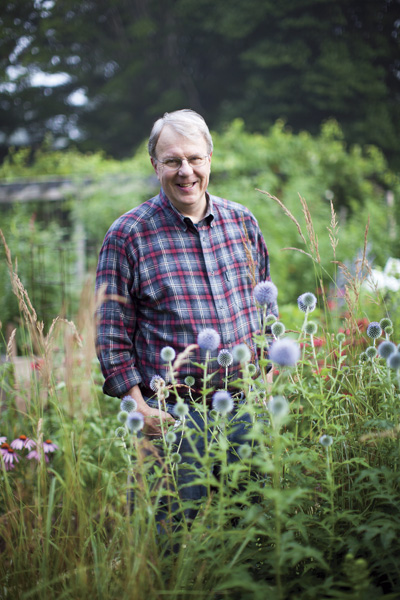The Incredible, Edible Garden
The fact that Thomas Gardner is a foodie is written all over his landscape. Likewise, his fondness for flowers. Merge the two, and you have an Eden where dahlias jostle tomatoes and marigolds weave into peppers, with pawpaws loitering not far away. Because Tom sees no reason to segregate his summer squash or to banish […]

The fact that Thomas Gardner is a foodie is written all over his landscape. Likewise, his fondness for flowers. Merge the two, and you have an Eden where dahlias jostle tomatoes and marigolds weave into peppers, with pawpaws loitering not far away. Because Tom sees no reason to segregate his summer squash or to banish the beans to a plot far from his lilies, he can stroll down his rows and pick the makings for bountiful bouquets and killer salads, too.
Juggling flowers and food can be tricky, it’s true. Fruit trees throw shade that may block blooms beneath them; cabbages muscle out anything minuscule nearby by season’s end; and asparagus can be a bully if you let it grow out. But Tom Gardner’s peaceable kingdom is all about harmony. It’s also the expression of a lifelong dream.
Gardner was raised in Ohio, where his family ran a successful food business. He came by his love of horticulture at an early age; he dug his first plot at the age of 10. Later, as a frustrated New Yorker working as a consultant for performing-arts organizations, he tucked pocket garden plots into the shadows of brownstones. But on a weekend trip to the Berkshires in 1989 while working for Shakespeare & Company, he fell in love with a 1750 house and abandoned dairy farm.
The moment the land was his, Gardner started striping the hill behind the house with rows of vegetables, flowers, and bulbs. He mapped out his designs, chose the plants, and solicited help from professional gardener Peter Martin, who tackles much of the considerable upkeep.
It could have been a mêlée. But instead, carefully calculated combinations are thriving. Every year the puzzle pieces are reconfigured, but a few constant rules keep everything in check. For example, Gardner anchors both ends of his ground beds with fruit-bearing trees and berry bushes. (He also stretches his garden’s horizons with such arcane ingredients as medlars, a type of ancient apple-like fruit, and tayberries, cousins of the boysenberry.) What about the shade they create? Not a problem when the branches are thinned and spread with wedges and weights to keep them apart. Berries are disciplined onto their own supports so that they won’t tangle with their bedfellows. And hungry veggies that don’t play well with others, such as corn and squash, are put in their own separate plots.
As for flowers, Gardner approaches perennials, annuals, and bulbs with an artistic eye–as well as a slight attitude toward color. No pink is permitted, partly because it clashes with the mustard-colored house, but also because Gardner simply doesn’t like it. Flower crops are planted successively to keep Gardner in blooms through the summer. Meanwhile, frequent dividing keeps the perennials in check.
Of course, all this goodness takes considerable fertility. Granted, the place used to be a dairy farm, where fertilizer was abundant. But the garden’s oomph is upped thanks to the compost created by the heirloom chickens, geese, ducks, and sheep that graze the fields. They’re protected from coyotes by Gardner’s pack of 17 Australian shepherds and Maremmas. Thanks to their viligance, deer and other four-legged nibblers aren’t an issue, either.
As for Tom Gardner, he’s literally got it all: marigolds, figs, amaranth, raspberries, beebalm, quince, chamomile … He lives hand to mouth. In a nutshell, he can have his garden and eat it, too.







